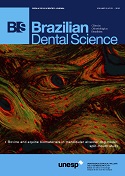Association of chlorhexidine and high fluoride dentifrice on Streptococcus mutans viability using an in vitro biofilm model
DOI:
https://doi.org/10.14295/bds.2016.v19i3.1258Abstract
Objective. This in vitro study investigated the effect of Fluoride (F), Chlorhexidine (CHX), and their association on the viability of Streptococcus mutans using a biofilm model. Materials and Methods. Biofilms were anaerobically grown on glass slides that were vertically suspended in 24-well plates for 5 days. After 48 h of initial growth, biofilms were treated for the next 72 h, 2x/day with CHX at 0.12% and 2%, F as NaF at 0.08% and 0.4% and their association. Results. CHX treatment decreased the bacteria counts either alone or in association with both F concentrations, when compared with control group and the F treatments alone (p<0.05). Conclusion. No addition effect was observed when CHX and F were used in combination, when compared with CHX used alone.
Downloads
Downloads
Published
How to Cite
Issue
Section
License
Brazilian Dental Science uses the Creative Commons (CC-BY 4.0) license, thus preserving the integrity of articles in an open access environment. The journal allows the author to retain publishing rights without restrictions.
=================




























